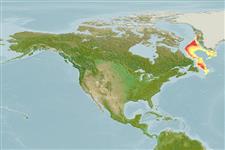Classification / Names
Noms communs | Synonymes | Catalog of Fishes(Genre, Espèce) | ITIS | CoL | WoRMS | Cloffa
Environment: milieu / climate zone / depth range / distribution range
Écologie
marin bathydémersal; profondeur 0 - 3172 m (Ref. 58018). Deep-water
Northwest Atlantic: south of Greenland.
Taille / Poids / Âge
Maturity: Lm ? range ? - ? cm
Max length : 4.8 cm SL (female)
Description synthétique
Clés d'identification | Morphologie | Morphométrie
Rayons mous dorsaux (Total) : 38; Rayons mous anaux: 31 - 33; Vertèbres: 43. Coronal pore present. Opercular flap large, triangular and prominent, anus on vertical through gill opening. Gill opening reaching ventrally in front of 2-3 pectoral rays. Gill rakers unmodified. Pectoral fin rays of lower lobe equal in thickness to rays of upper pectoral fin lobe. Skin with yellowish-brown patterns; head beneath skin blackish-brown; gill arches and gill cavity brownish-black (Ref. 43481).
Life cycle and mating behavior
Maturité | Reproduction | Frai | Œufs | Fécondité | Larves
Chernova, N.V. and D.L. Stein, 2002. Ten new species of Psednos (Pisces, Scorpaeniformes: Liparidae) from the Pacific and North Atlantic oceans. Copeia 2002(3):755-778. (Ref. 43481)
Statut dans la liste rouge de l'IUCN (Ref. 130435: Version 2024-1)
Menace pour l'homme
Harmless
Utilisations par l'homme
Outils
Articles particuliers
Télécharger en XML
Sources Internet
Estimates based on models
Preferred temperature (Ref.
123201): 3.3 - 4.3, mean 3.7 °C (based on 65 cells).
Phylogenetic diversity index (Ref.
82804): PD
50 = 0.5000 [Uniqueness, from 0.5 = low to 2.0 = high].
Bayesian length-weight: a=0.01000 (0.00244 - 0.04107), b=3.04 (2.81 - 3.27), in cm total length, based on all LWR estimates for this body shape (Ref.
93245).
Niveau trophique (Ref.
69278): 3.2 ±0.6 se; based on size and trophs of closest relatives
Résilience (Ref.
120179): Haut, temps minimum de doublement de population inférieur à 15 mois (Preliminary K or Fecundity.).
Fishing Vulnerability (Ref.
59153): Low vulnerability (10 of 100).
